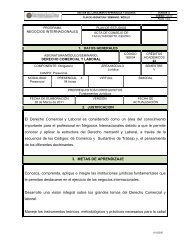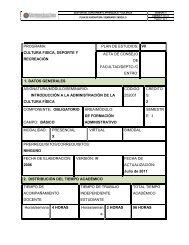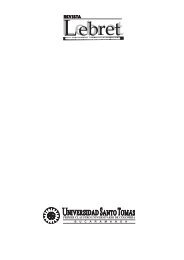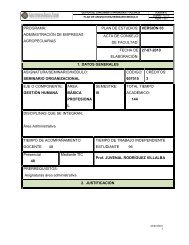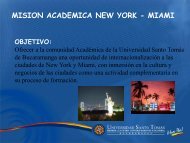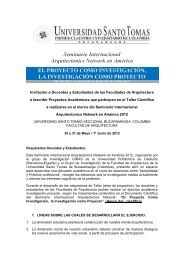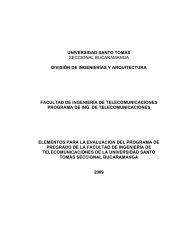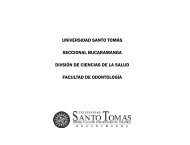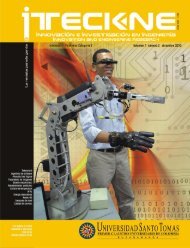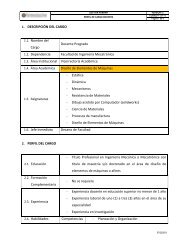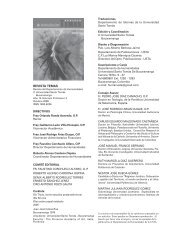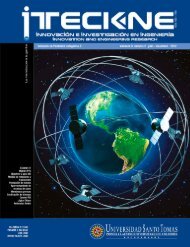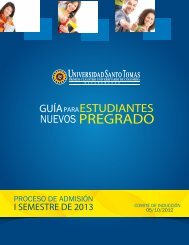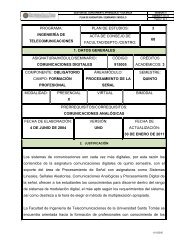un estudio in vitro - universidad santo tomas de bucaramanga
un estudio in vitro - universidad santo tomas de bucaramanga
un estudio in vitro - universidad santo tomas de bucaramanga
- No tags were found...
You also want an ePaper? Increase the reach of your titles
YUMPU automatically turns print PDFs into web optimized ePapers that Google loves.
Ustasalud is a scientific semiannual journal published by<br />
the Dental School from Santo Tomas University <strong>in</strong> Bucaramanga<br />
(Colombia). It covers a variety of scientific research,<br />
ma<strong>in</strong>ly, <strong>in</strong> <strong>de</strong>ntal topics. The journal will publish<br />
orig<strong>in</strong>al and scientific papers, review articles, case reports,<br />
comments and letters to Editor, prelim<strong>in</strong>ary research reports<br />
and theme reviews. All manuscripts published are<br />
previously approved by the Editorial Board and should be<br />
based <strong>in</strong> accordance with the Uniform Requirements for<br />
Manuscripts Submitted to Biomedical Journals, International<br />
committee of Medical Journal Editors. JAMA 1993;<br />
269: 2282 – 2286 (http://www.icmje.org).<br />
The articles sent for publication should be <strong>un</strong>published<br />
and could be written <strong>in</strong> languages other than Spanish.<br />
Published papers do not necessarily represent the views<br />
of the Editorial and Scientific Board, that is, the concepts<br />
emitted <strong>in</strong> the manuscript are of the author’s exclusive<br />
responsibility. The papers presented to Ustasalud will be<br />
peer review by anonymous referees after be<strong>in</strong>g accepted<br />
by the Editorial and Scientific Board. Authors are <strong>in</strong>formed<br />
of acceptance, rejection with suggestions or rejection<br />
of the paper up to eight weeks after manuscript submission.<br />
Ustasalud will take copyright from the author so for<br />
any reproduction and repeated publish<strong>in</strong>g of the paper,<br />
written consent from Ustasalud is requested.<br />
Manuscript submission<br />
- The manuscript should be sent, by e-mail, ustasalud@<br />
mail.ustabuca.edu.co. It will not be accepted works out of<br />
norms. The text should be prepared <strong>in</strong> A4 paper with 1,5<br />
l<strong>in</strong>e space (Arial font, body 12). They should be typed <strong>in</strong><br />
Microsoft Word®.<br />
- Support material such as tables, illustrations, photographs,<br />
charts, diagrams or other similar material must be<br />
i<strong>de</strong>ntified and attached <strong>in</strong> different files from the text, <strong>in</strong><br />
the same e-mail. This material should be related <strong>in</strong> the<br />
exact or<strong>de</strong>r of appearance <strong>in</strong> the body of the work.<br />
- If you <strong>in</strong>clu<strong>de</strong> material from other publications or authors,<br />
it must be cited the source or the permission to use<br />
such material.<br />
- The presentation of the article <strong>in</strong>clu<strong>de</strong>s <strong>in</strong> or<strong>de</strong>r: Title<br />
(<strong>in</strong> English and Spanish or another language), full name of<br />
the authors separated by comma, <strong>in</strong>stitutional affiliation<br />
(without abbreviation) of every author with its correspond<strong>in</strong>g<br />
i<strong>de</strong>ntification number, address, phone number, nationality<br />
and e-mail address. It is also required a responsible<br />
author. Abstract (<strong>in</strong> English and Spanish or another<br />
language), keywords (<strong>in</strong> English and Spanish or another<br />
language), <strong>in</strong>troduction, methods, results, discussion and<br />
bibliography.<br />
- Articles should be written <strong>in</strong> generic language, avoid<br />
slang and regionalism that could bias the <strong>in</strong>terpretation<br />
of the <strong>in</strong>formation presented. Papers should express their<br />
own f<strong>in</strong>d<strong>in</strong>gs <strong>in</strong> past tense and should give preference to<br />
the third person’s and impersonal form.<br />
ORIGINAL ARTICLES<br />
Abstract and Keywords:<br />
The abstract is an overview of the most important aspects<br />
of the article. This should be structured and presented <strong>in</strong><br />
both English and Spanish or another language, should<br />
INSTRUCTIONS FOR AUTHORS<br />
be written <strong>in</strong> an attractive manner to <strong>in</strong>vite the rea<strong>de</strong>r<br />
to learn the subject matter <strong>in</strong> greater <strong>de</strong>tail. The abstract<br />
should be <strong>in</strong>clu<strong>de</strong>d on the second page of the presentation<br />
not to exceed the two h<strong>un</strong>dred and fifty (250) words. The<br />
paper should <strong>in</strong>clu<strong>de</strong> three to five key words that allow<br />
the <strong>de</strong>velopment of cross-references; these words <strong>in</strong>dicate<br />
the <strong>de</strong>scriptors <strong>in</strong> English so you can consult “Medical<br />
Subject Head<strong>in</strong>gs” [MeSH].<br />
Introduction:<br />
The <strong>in</strong>troduction of the paper presents a frame of reference<br />
and the <strong>in</strong>fluential elements. State the objective of the<br />
research.<br />
Methods:<br />
Applied methodological aspects should be consi<strong>de</strong>red as<br />
follows:<br />
- Study <strong>de</strong>sign and selection process of the subjects of the<br />
experiment or observation (patients and / or laboratory<br />
animals). They must i<strong>de</strong>ntify age, gen<strong>de</strong>r, race or ethnicity<br />
(k<strong>in</strong>d for animals) and subject-specific characteristics relevant<br />
to the study.<br />
- Must be reviewed, clearly, a brief <strong>de</strong>scription of the <strong>in</strong>struments,<br />
policies, procedures and methods applied to the<br />
study, especially those of little knowledge, so that if necessary<br />
allow its reproduction.<br />
- Consi<strong>de</strong>r a brief <strong>de</strong>scription of <strong>in</strong>dicators and variables<br />
so as to be <strong>un</strong><strong>de</strong>rstandable by a rea<strong>de</strong>r of any level of<br />
knowledge of the area.<br />
- Provi<strong>de</strong> the number of tables, charts or material necessary<br />
for the exposure issue.<br />
- Describe the analytical methodology used for <strong>in</strong>formation<br />
management and presentation of results.<br />
Legal and ethical issues:<br />
When report<strong>in</strong>g experiments on humans or animals, <strong>in</strong>dicate<br />
whether the procedures followed were <strong>in</strong> accordance<br />
with the ethical standards of the <strong>in</strong>stitutional, regional or<br />
national committee responsible or the Declaration of Hels<strong>in</strong>ki,<br />
1975, revised <strong>in</strong> 1983.<br />
Photographs from patients must have the written permission<br />
for publication; avoid us<strong>in</strong>g names, <strong>in</strong>itials or<br />
i<strong>de</strong>ntification numbers from them or from the <strong>in</strong>stitutions<br />
where they have been seen. The photos must be submitted<br />
as digital image files <strong>in</strong> a TIFF format, <strong>in</strong> 10 x 15 cm<br />
m<strong>in</strong>imum size and 300 dpi resolution. Images <strong>in</strong>serted <strong>in</strong><br />
text and out of focus will not be accepted.<br />
Results:<br />
They must be presented <strong>in</strong> a logical way <strong>in</strong> the text, tables<br />
and illustrations. Do no repeat <strong>in</strong> the text all the <strong>in</strong>formation<br />
given <strong>in</strong> the tables and figures; emphasize or summarize<br />
only important observations.<br />
Discussion:<br />
This section should be the <strong>in</strong>terpretation of the observations<br />
from the study, emphasiz<strong>in</strong>g the new and important<br />
aspects of the study and the conclusions that follow from<br />
them. This should <strong>in</strong>clu<strong>de</strong> the implications of the f<strong>in</strong>d<strong>in</strong>gs,<br />
their limitations and relationships with results from similar<br />
studies. The recommendations for future studies are<br />
also <strong>in</strong>clu<strong>de</strong>d.<br />
Revista<br />
UstaSalud<br />
65



